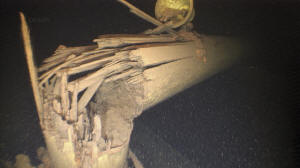Explorers discover wreckage of cargo ship that sank in Lake Superior
storm more than 130 years ago
[March 12, 2025]
By TODD RICHMOND
MADISON, Wis. (AP) — Twenty years before the Titanic changed maritime
history, another ship touted as the next great technological feat set
sail on the Great Lakes.
The Western Reserve was one of the first all-steel cargo ships to
traverse the lakes. Built to break speed records, the 300-foot
(91-meter) freighter dubbed “the inland greyhound” by newspapers was
supposed to be one of the safest ships afloat. Owner Peter Minch was so
proud of her that he brought his wife and young children aboard for a
summer joyride in August 1892.
As the ship entered Lake Superior's Whitefish Bay between Michigan and
Canada on Aug. 30, a gale came up. With no cargo, the ship was floating
high in the water. The storm battered it until it cracked in half.
Twenty-seven people perished, including the Minch family. The only
survivor was wheelsman Harry W. Stewart, who swam a mile (1.6
kilometers) to shore after his lifeboat capsized.
For almost 132 years, the lake hid the wreckage. In July, explorers from
the Great Lakes Shipwreck Historical Society pinpointed the Western
Reserve off Michigan's Upper Peninsula. The society announced the
discovery Saturday at the annual Ghost Ships Festival in Manitowoc,
Wisconsin.
“There's a number of concurrent stories that make this important,” the
society's executive director, Bruce Lynn, said in a telephone interview.
“Most ships were still wooden. It was a technologically advanced ship.
They were kind of a famous family at the time. You have this new ship,
considered one of the safest on the lake, new tech, a big, big ship.
(The discovery) is another way for us to keep this history alive.”

Search lasted more than two years
Darryl Ertel, the society's marine operations director, and his brother,
Dan Ertel, spent more than two years looking for the Western Reserve. On
July 22, they set out on the David Boyd, the society's research vessel.
Heavy ship traffic that day forced them to alter their course, though,
and search an area adjacent to their original search grid, Lynn said.
The brothers towed a side-scanning sonar array behind their ship. Side
sonar scans starboard and port, providing a more expansive picture of
the bottom than sonar mounted beneath a ship. About 60 miles (97
kilometers) northwest of Whitefish Point on the Upper Peninsula, they
picked up a line with a shadow behind it in 600 feet (182 meters) of
water. They dialed up the resolution and spotted a large ship broken in
two with the bow resting on the stern.
Confirmation day
Eight days later, the brothers returned to the site along with Lynn and
other researchers. They deployed a submersible drone that returned clear
images of a portside running light that matched a Western Reserve’s
starboard running light that had washed ashore in Canada after the ship
went down. That light was the only artifact recovered from the ship.
[to top of second column]
|

This image provided by Great Lakes Shipwreck Historical Society
shows the broken mast from the Western Reserve, a merchant ship that
sank in Lake Superior in 1892 off Michigan’s Upper Peninsula. (Great
Lakes Shipwreck Historical Society via AP)

“That was confirmation day,” said Lynn, the society's executive
director.
Darryl Ertel said that discovery gave him chills — and not in a good
way. “Knowing how the 300-foot Western Reserve was caught in a storm
this far from shore made a uneasy feeling in the back of my neck,"
he said in a society news release. "A squall can come up
unexpectedly…anywhere, and anytime.”
Lynn said that the ship was “pretty torn up” but the wreckage
appeared well-preserved in the frigid fresh water.
The Great Lakes can be more dangerous than the oceans
The Great Lakes have claimed thousands of ships since the 1700s.
Perhaps the most famous is the Edmund Fitzgerald, an ore carrier
that got caught in a storm in November 1975 and went down off
Whitefish Point within 100 miles (160 kilometers) of the Western
Reserve. All hands were killed. The incident was immortalized in the
Gordon Lightfoot song, “The Wreck of the Edmund Fitzgerald."
Assistant Wisconsin State Climatologist Ed Hopkins said that storm
season on the lakes begins in November, when warm water meets cold
air and winds blow unimpeded across open water, generating waves as
high as 30 feet (9 meters). The lakes at that time can be more
dangerous than the oceans because they're smaller, making it harder
for ships to out-maneuver the storms, he said.
Brittle steel may have played a role in sinking
But it's rare to see such gales form in August, Hopkins said. A
National Weather Service report called the storm that sank the
Western Reserve a “relatively minor gale," he noted.
A Wisconsin Marine Historical Society summary of the Western Reserve
sinking noted that the maritime steel age had just begun and the
Western Reserve's hull might have been weak and couldn't handle the
bending and twisting in the storm. The steel also becomes brittle in
low temperatures like those of Great Lakes waters. The average water
temperature in Lake Superior in late August is about 60 degrees (16
degrees Celsius), according to the National Oceanic and Atmospheric
Administration.
The summary notes the Titanic used the same type of steel as the
Western Reserve and that it may have played a role in speeding up
the luxury liner's sinking.
All contents © copyright 2025 Associated Press. All rights reserved
 |